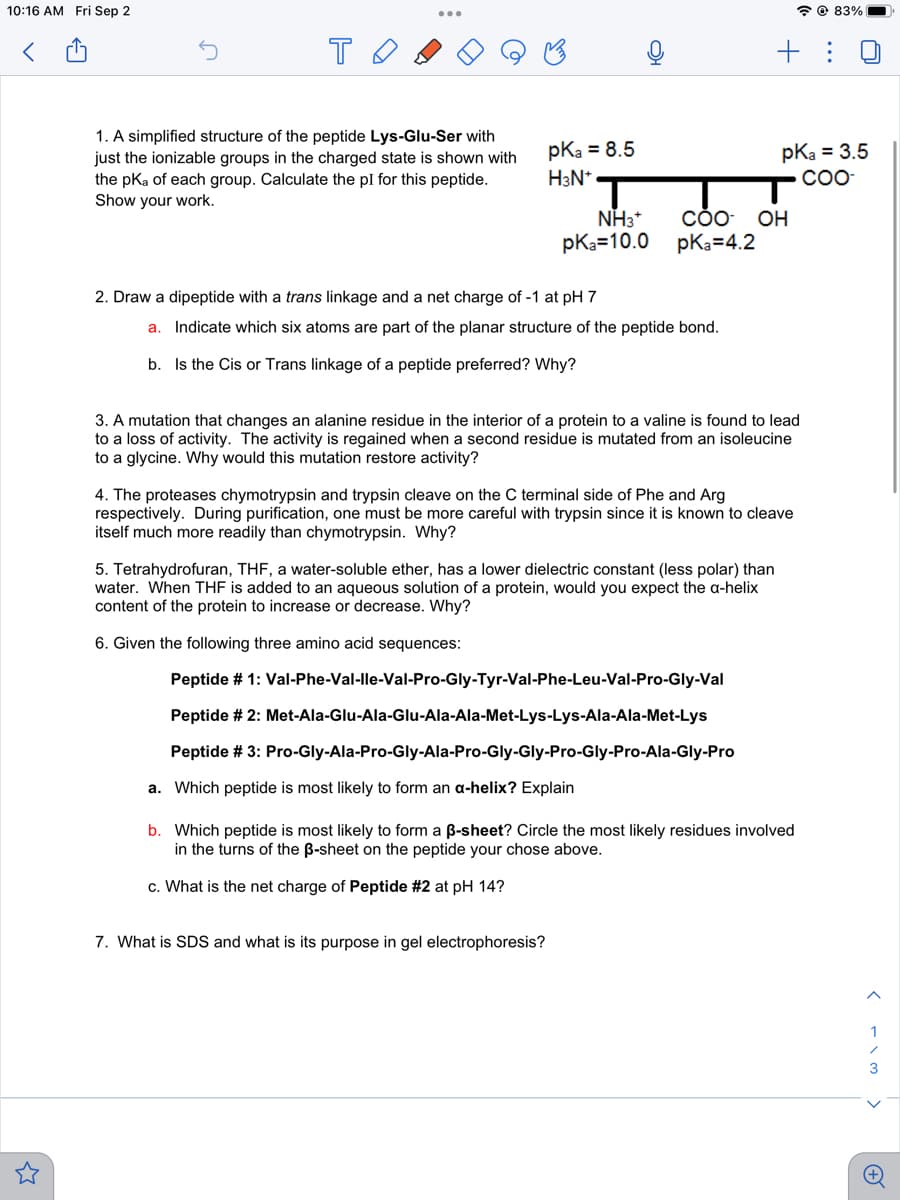3. A mutation that changes an alanine residue in the interior of a protein to a valine is found to lead to a loss of activity. The activity is regained when a second residue is mutated from an isoleucine to a glycine. Why would this mutation restore activity?
3. A mutation that changes an alanine residue in the interior of a protein to a valine is found to lead to a loss of activity. The activity is regained when a second residue is mutated from an isoleucine to a glycine. Why would this mutation restore activity?
Biology 2e
2nd Edition
ISBN:9781947172517
Author:Matthew Douglas, Jung Choi, Mary Ann Clark
Publisher:Matthew Douglas, Jung Choi, Mary Ann Clark
Chapter3: Biological Macromolecules
Section: Chapter Questions
Problem 23CTQ: Amino acids have the generic structure seen below, where R represents different carbon-based side...
Related questions
Question
3

Transcribed Image Text:10:16 AM Fri Sep 2
<
то
1. A simplified structure of the peptide Lys-Glu-Ser with
just the ionizable groups in the charged state is shown with
the pKa of each group. Calculate the pl for this peptide.
Show your work.
pka = 8.5
H3N+
NH3*
pKa 10.0
2. Draw a dipeptide with a trans linkage and a net charge of -1 at pH 7
a. Indicate which six atoms are part of the planar structure of the peptide bond.
b. Is the Cis or Trans linkage of a peptide preferred? Why?
COO- OH
pka=4.2
3. A mutation that changes an alanine residue in the interior of a protein to a valine is found to lead
to a loss of activity. The activity is regained when a second residue is mutated from an isoleucine
to a glycine. Why would this mutation restore activity?
5. Tetrahydrofuran, THF, a water-soluble ether, has a lower dielectric constant (less polar) than
water. When THF is added to an aqueous solution of a protein, would you expect the a-helix
content of the protein to increase or decrease. Why?
6. Given the following three amino acid sequences:
7. What is SDS and what is its purpose in gel electrophoresis?
+:
4. The proteases chymotrypsin and trypsin cleave on the C terminal side of Phe and Arg
respectively. During purification, one must be more careful with trypsin since it is known to cleave
itself much more readily than chymotrypsin. Why?
Peptide # 1: Val-Phe-Val-lle-Val-Pro-Gly-Tyr-Val-Phe-Leu-Val-Pro-Gly-Val
Peptide # 2: Met-Ala-Glu-Ala-Glu-Ala-Ala-Met-Lys-Lys-Ala-Ala-Met-Lys
Peptide # 3: Pro-Gly-Ala-Pro-Gly-Ala-Pro-Gly-Gly-Pro-Gly-Pro-Ala-Gly-Pro
a. Which peptide is most likely to form an a-helix? Explain
pka = 3.5
COO-
@83%
b. Which peptide is most likely to form a ß-sheet? Circle the most likely residues involved
in the turns of the ß-sheet on the peptide your chose above.
c. What is the net charge of Peptide #2 at pH 14?
(113
+
Expert Solution
This question has been solved!
Explore an expertly crafted, step-by-step solution for a thorough understanding of key concepts.
This is a popular solution!
Trending now
This is a popular solution!
Step by step
Solved in 3 steps

Recommended textbooks for you

Biology 2e
Biology
ISBN:
9781947172517
Author:
Matthew Douglas, Jung Choi, Mary Ann Clark
Publisher:
OpenStax

Biology 2e
Biology
ISBN:
9781947172517
Author:
Matthew Douglas, Jung Choi, Mary Ann Clark
Publisher:
OpenStax